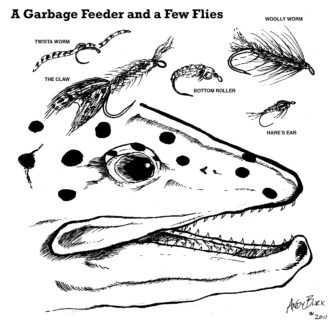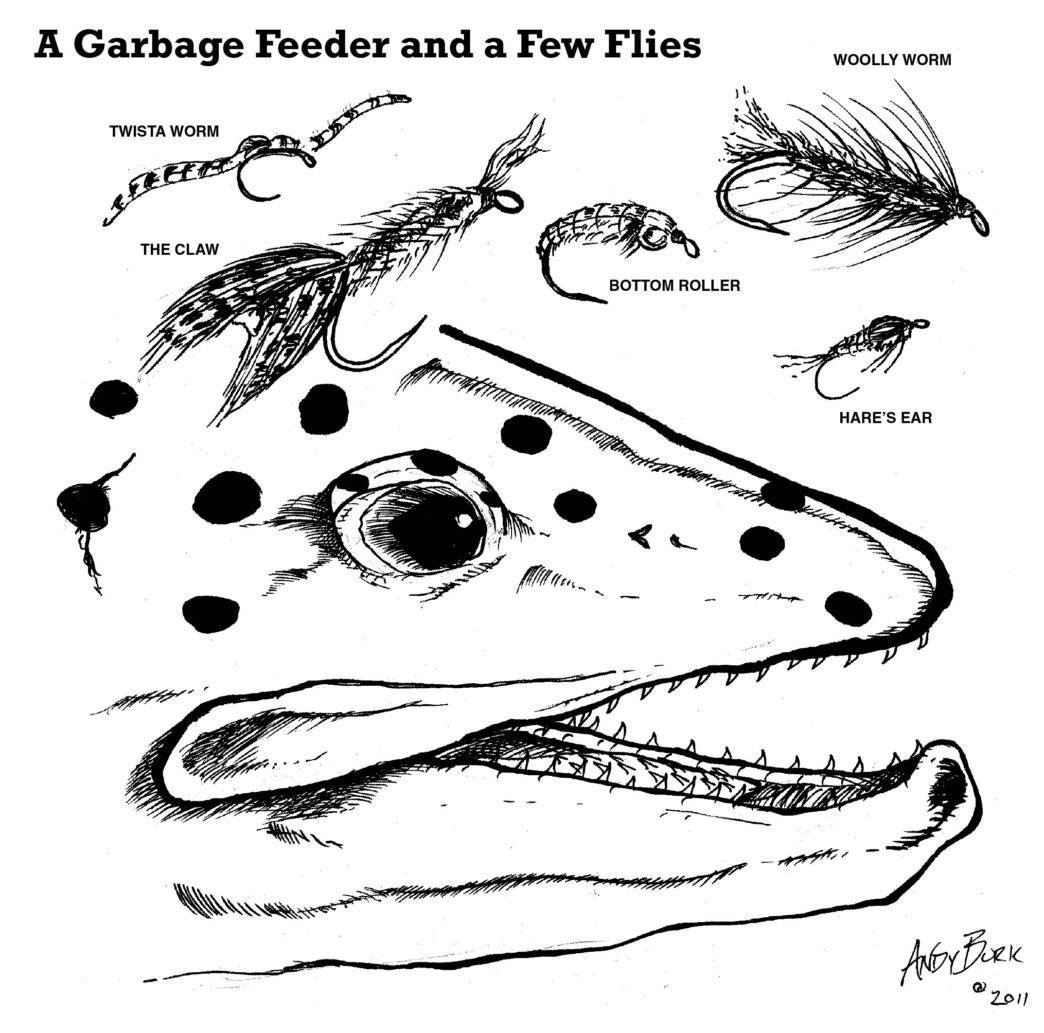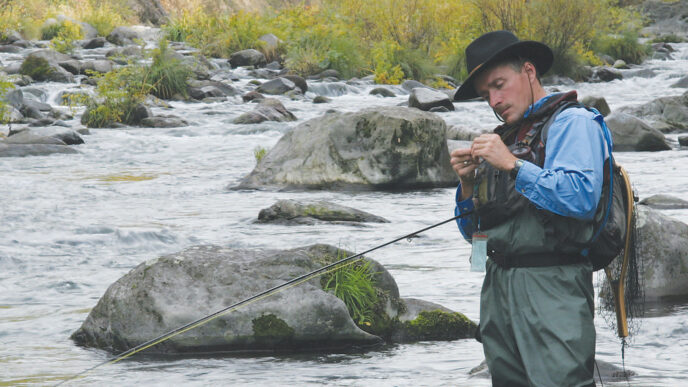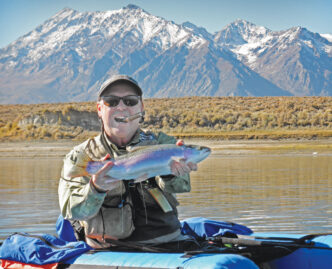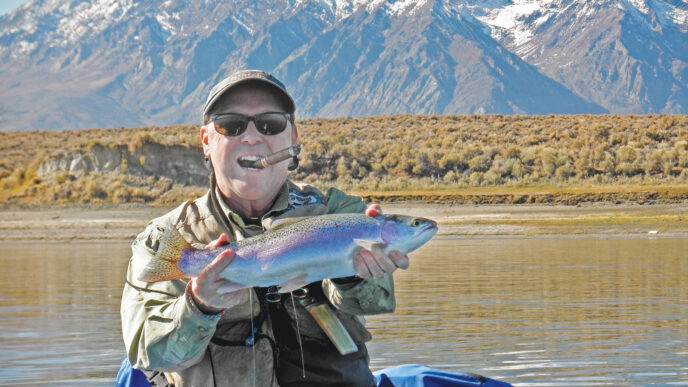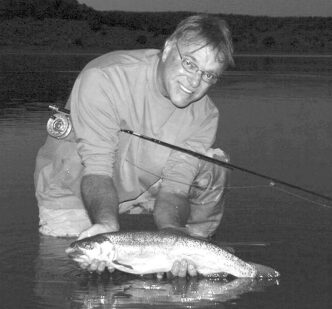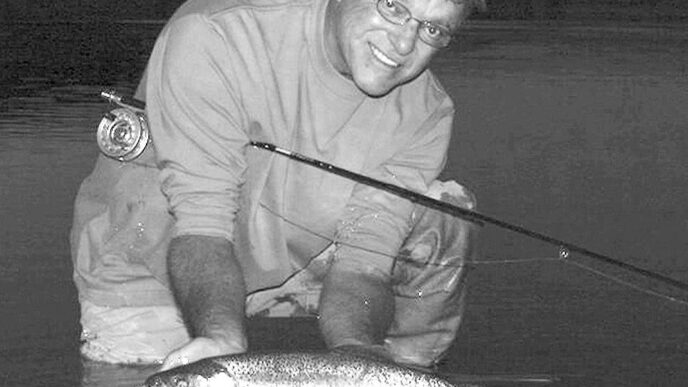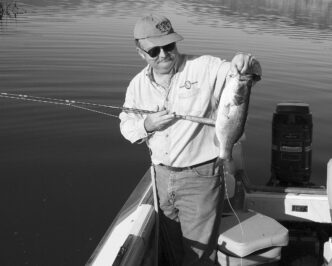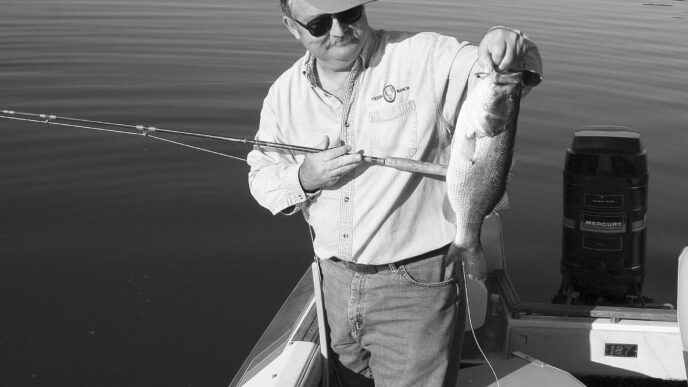My home river, the Truckee, can be a frustrating, demanding, and ultimately rewarding stream to fish. I get to fish it year-round and see the it under all types of conditions. This year, every river in the state seemed to have higher than normal flows that lasted through spring and well into summer, flows that were both a blessing and a curse for most of the anglers I know. No doubt you found yourself challenged at times by the unusual speed and size of the streams you fished. Now that those high flows are finally a memory, I thought it would be a good idea to put some focus on a few new tricks I learned during our short summer season.
Tailing Trout
Twice this year, I’ve spotted trout in the Truckee with their noses down and their tails breaking the surface, much as trout in spring creeks and lakes will tail as they grub around the bottom, picking off snails, scuds, and other morsels of food. In both instances, I made presentations to the tailing trout. I hooked one briefly on a caddis-larva colored Bottom Roller and lost the fish as it turned and rubbed its head on the bottom, dislodging the fly. The second fish I spooked due to a poor presentation. A trout tailing in water less than two feet deep apparently doesn’t like the sound of a size 10 heavily weighted Bottom Roller plopping on its head. The biggest discovery, though, was seeing how many fish were actively feeding this way in the tailout zones of the Truckee.
I waded out into tailouts where I saw the fish tailing and was not surprised to find the rocks were covered with cased caddis and a few diving egg-laying caddis. A couple of juvenile crayfish scurried out of my way, too. I soon realized that there were more fish hanging in these tailout zones than I had originally suspected. A couple of sharp-eyed anglers also related their experiences with tailing fish and fish in tailouts. In a high-water year, there is simply more water in these areas, and fish are taking advantage of it. I see many anglers hiking down the river bank and looking for a place to cross. When they find the spot, they just wade right through it. Oooops! You may have just scared away the fish of the season.
One thing that I’m pretty sure of is that when you find fish hanging out in the tailout zone, you are dealing with actively feeding fish, and those are the best kind. The approach when fishing the tailout zone must be extra stealthy, though, because the fish are already on their guard in shallow water, where their senses are sharply tuned to threats. If you do it right and sneak along the bank, using available streamside cover, you’ll be able to get a shot at some sizeable trout. Creep along the bank with your polarized sunglasses on and carefully scan the tailout for visible fish. If you don’t spot any fish, carefully observe the tailout, looking for the biggest rocks, wood, or other debris that fish might use as cover or, more importantly, as an ambush point.
If there are a few bugs around, it’s always worth trying a dry fly, such as a caddis pattern or Little Yellow Stone adult. These fish may have fed heavily on the hatching insects the previous evening and will still make the move and eat the last stray bug or two off the top.
While it’s worth a shot with a dry, the most consistent way to catch tailout trout is to fish subsurface using a variety of nymphs, crayfish patterns, and small baitfish imitations. Examine the bug life in these zones and choose your fly based on what you see there. My best success has come with midsized weighted nymphs such as Bottom Rollers and Aggravators. I don’t use an indicator when I’m fishing the tailout zone, because I find that many of the grabs have come just as the fly starts to swing up off the bottom.
I like to use a 10-foot leader that is tapered to 3X or 4X and tie on a couple of feet of 4X or 5X tippet, depending on what fly I’m using. If I’m sight fish, I make my presentation a few feet above the target so that the fly has time to sink into the fish’s zone. It will take you a little while to get to the point where you can judge exactly how far above the fish you need to cast the fly, but it will usually be anywhere from 3 to 10 feet upstream. A reach cast will help you to set up your drift properly. Once the cast is made and the fly is drifting toward the fish, pay close attention to the point of the line and to the fish, if it is visible. If anything unusual happens, respond immediately by tightening the line using a short, sharp strip strike. The strip strike lets you avoid the possibility of yanking the fly out of the water directly in front of the fish on a missed strike. As I said, many grabs have come as the fly starts to swing up and out of the depths.
Garbage Feeders in Backwaters and Swirlies
I’m sure you have noticed that most of the insect hatches in our favorite rivers have been shortened or in many cases late this year, leading to oddities like March Browns hatching in July. It was definitely a year when having a fly box filled with a wide variety of hatch-matching bugs paid off. I often found, however, that close enough was more than adequate when it came to imitations, due to the huge variety of insects available to the fish. In fact, for a couple of weeks, I made it a point not even to try to match the predominant hatch. I decided to spend my time pursuing what we’ll call “garbage feeders.” These fish are the real opportunists of the river. Also, they are often the largest browns and rainbows in the system. They hang out in many of the normal places where you find big trout, but due to their penchant for eating all kinds of different foods, you’ll often find them in a few spots where you may not be used to seeing huge fish. I have become a big fan of fishing for them in all the weird little backwaters and swirling, lazy Susan–type currents.
These spots are usually found in deep pools or very near deep-water ledges and drop-offs. On the Truckee, they are often caused by the layout of rocks and debris on the bottom. The one consistent feature of these areas is a slow, swirling current that acts like a conveyor belt, delivering a steady supply of food items for lazy garbage feeders to eat. Everything in the river gets caught in these swirlies at some point, and it’s not uncommon to see all kinds of offbeat stuff there. I watched a small mole caught in a swirly for several minutes before it was finally able to get to the river’s edge and safety. I had high hopes of seeing the poor little rodent get eaten by a big trout. It didn’t happen that time, but I plan on keeping my eyes open in case it does.
Fishing a swirly requires a fair bit of patience and little bit of figuring out how to get a good drift. Many times, you’ll be casting downriver, to the bottom of the swirly current, and drifting your fly upstream toward your position. Every one of these swirly currents is different. After you have fished a few, you’ll become an expert at where to cast to maximize your fishing time in the swirly.
I use a couple of different methods when fishing for garbage feeders in swirlies. The single most effective one is fishing a nymph-and-indicator setup. I typically rig with a single nymph, because many of these areas are loaded with debris, and you stand to losing a fair number of flies in these areas. In fact, I noticed last year that whenever I switched to a single-fly rig when I was nymphing, whatever the circumstances, I seemed to hook more fish.
But aren’t two flies better than one? Not always. The next time you’re out fishing, take note of the rigs that other anglers are using. I’ll bet that the rig you see most is an indicator setup with a large fly on the top and a smaller fly 18 to 24 inches behind and a split shot or two 8 to 10 inches above the top fly. The reason that this rig is so common is because of the success that it achieves. On heavily pressured rivers, though, I’m finding that going back to a single nymph while indicator fishing has actually increased my catch rate.
Look at it this way. There are a lot of us out there, and if we’re all using exactly the same method, the trout get tuned in to it. I’m not trying to make the fish seem smarter than they really are. For the most part, they are dumb critters with great instincts. Trout in heavily pressured water have gotten used to seeing food in pairs, because that’s the rig we anglers use most often. This means you must get the perfect drift to fool the larger, well-educated trout when fishing pressured water. I find that by changing to a single-fly rig, I not only find it easier to get a drift, but easier to fish, because I don’t have to rerig as much as a result of losing flies by the pair.
In backwaters and swirlies, I’ve not found that there is any one type of bug that works best, because these types of water act as catch basins for everything in the river. I may start out by dead drifting a crayfish pattern and end up stripping a mouse pattern across the surface. The key is to remain flexible and be willing to try different flies until you find what works. The swirlies are also a great place really late in the evening, because large brown trout will sometimes pull into a swirly zone to feed on smaller fish that may already be stationed there. A large, three-tofive-inch-long baitfish imitation of some sort can be just the thing to show to these big predators in that situation.
Big Dries and Slashing Rises
With higher than normal water conditions, another thing that I’ve found is that anglers who are willing to cover a lot of water and throw big attractor dries are pulling up some impressive fish from those hazardous spots where they might instead get easily snagged. The key to success is to get your fly to drift through all those places where others are afraid to cast. You know where I mean — the pocket, for example, with the overhanging, fly-eating bush and the big stump just subsurface. It’s the type of place that begs for a cast, but you just know that there is a small chance you’re not going to hang up and lose a fly. However, those few casts that actually get the fly on the water and not in the bush can pay off. Big alpha trout have a reputation for holding in lies that are impossible or nearly impossible to fish. The next time you see one of those spots, fish it! You may lose a fly, but you may also hook a monster. There has been a bumper crop of grasshoppers, beetles, ants, and moths this year, so all kinds of bugs can end up on the menu that trout see. In that sense, most trout this year have been garbage feeders. When fishing for them with big dries in snag-ridden spots, I typically rig with a 71/2-foot leader that tapers down to 3X or 4X and tie on whatever my favorite big dry of the day is.
Lately, I’ve been fooling around with a floating version of my Aggravator design. It looks a little like the original Aggravator, but it’s got a foam wing case and a spun deer hair thorax for added floatation. It also features a wiggly set of Sili Legs for extra trout-attracting life. I fish the floating Aggravator in much the same way as you would fish a popper for bass: cast it out and let it swim on the surface for a foot or two before you give it a twitch. The strikes are usually few and far between using this method, but the explosiveness of the take and the larger-sized fish that you can fool with it make it a worthy tactic to add to your arsenal.
This high water-year has given the California fly fisher a whole bunch of new angling options to try. The great thing about our state and the anglers who fish it is that there are always unique and unusual opportunities for sport. So what are you waiting for? It’s time to go fishing for tailing trout in tailouts and for garbage feeders in swirlies and in dangerous lies with big dries.



